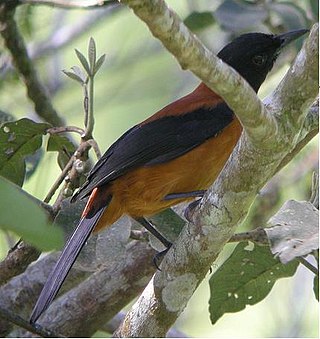
The hooded pitohui is a species of bird in the genus Pitohui found in New Guinea. It was long thought to be a whistler (Pachycephalidae) but is now known to be in the Old World oriole family (Oriolidae). Within the oriole family, this species is most closely related to the variable pitohuis in the genus Pitohui, and then the figbirds.

Batrachotoxin (BTX) is an extremely potent cardiotoxic and neurotoxic steroidal alkaloid found in certain species of beetles, birds, and frogs. The name is from the Greek word βάτραχος, bátrachos, 'frog'. Structurally-related chemical compounds are often referred to collectively as batrachotoxins. In certain frogs, this alkaloid is present mostly on the skin. Such frogs are among those used for poisoning darts. Batrachotoxin binds to and irreversibly opens the sodium channels of nerve cells and prevents them from closing, resulting in paralysis and death. No antidote is known.

Buprestidae is a family of beetles known as jewel beetles or metallic wood-boring beetles because of their glossy iridescent colors. Larvae of this family are known as flatheaded borers. The family is among the largest of the beetles, with some 15,500 species known in 775 genera. In addition, almost 100 fossil species have been described.

The blue poison dart frog or blue poison arrow frog is a poison dart frog found in the "forest islands" surrounded by the Sipaliwini Savanna in southern Suriname. Its indigenous Tiriyo name is okopipi. The name "azureus" comes from its azure blue color. While first described as a valid species and usually recognized as such in the past, recent authorities generally treat it as a morph of D. tinctorius, although a few treat it as a subspecies of D. tinctorius or continue to treat it as its own species. To what extent it differs from the blue D. tinctorius in southern Guyana, adjacent Pará (Brazil) and possibly far southwestern Suriname, is also a matter of dispute, and many herpetologists, as well as many people keeping poison dart frogs in captivity, have not distinguished these, with all commonly being identified as "azureus".
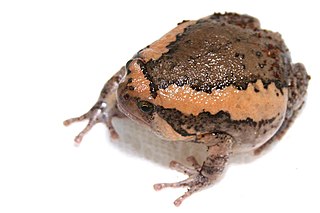
Kaloula is a genus of microhylid frogs found in southern and eastern Asia. They are sometimes known as the Asian narrowmouth toads.

The golden poison frog, also known as the golden dart frog or golden poison arrow frog, is a poison dart frog endemic from the rainforests of Colombia. The golden poison frog has become endangered due to habitat destruction within its naturally limited range. Despite its small size, this frog is considered to be the most poisonous extant animal species on the planet.

The blue-capped ifrit, also known as the blue-capped ifrita, is a small and insectivorous passerine species currently placed in the monotypic family, Ifritidae. Previously, the ifrit has been placed in a plethora of families including Cinclosomatidae or Monarchidae. Blue-capped ifrits are considered an ancient relict species endemic to New Guinea. This corvoid species originally dates back to the Oligocene epoch, on a series of proto-Papuan islands, with minimal known evolutionary divergences.

Phyllobates is a genus of poison dart frogs native to Central and South America, from Nicaragua to Colombia. There are 3 different Colombian species of Phyllobates, considered highly toxic species due to the poison they contain in the wild.

The fauna of New Guinea comprises a large number of species of mammals, reptiles, birds, fish, invertebrates and amphibians.
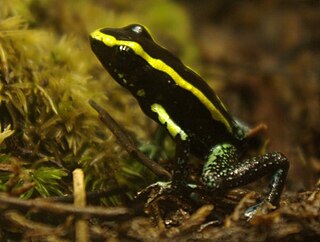
Phyllobates aurotaenia is a member of the frog family Dendrobatidae, which are found in the tropical environments of Central and South America. First described by zoologist George Albert Boulenger in 1913, P. aurotaenia is known for being the third most poisonous frog in the world. It is the smallest of the poison dart frogs in the Phyllobates genus and is endemic to the Pacific coast of Colombia.

The Golfodulcean poison frog or Golfodulcean poison-arrow frog is a species of frog in the family Dendrobatidae endemic to Costa Rica.
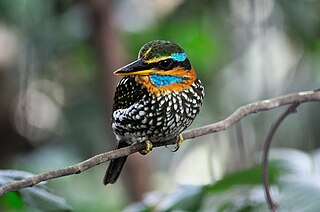
The spotted wood kingfisher or spotted kingfisher is a species of bird in the family Alcedinidae. It is endemic to the Philippines found on the islands of Luzon, Catanduanes, Marinduque, Negros and Panay where its natural habitat is tropical moist lowland forests.

The blue pitta is a species of bird in the family Pittidae found in the northeastern Indian subcontinent, southern China, and Indochina. It typically lives in moist forests but can also inhabit dry forest. It is an unobtrusive, solitary bird which feeds by foraging on the ground for insects and other small invertebrates.

Melyridae are a family of beetles of the superfamily Cleroidea.

Toxic birds are birds that use toxins to defend themselves from predators. Although no known bird actively injects or produces venom, toxic birds sequester poison from animals and plants they consume, especially poisonous insects. Species include the pitohui and ifrita birds from Papua New Guinea, the European quail, the spur-winged goose, hoopoes, the bronzewing pigeon, and the red warbler.
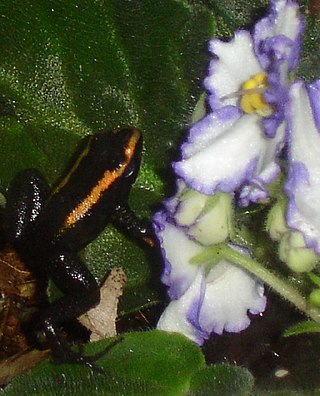
Phyllobates samperi, formerly known as sp. aff. aurotaenia is a new species of hypertoxic poison dart frog, once cited as the "red" form of Phyllobates aurotaenia. It resembles in size and to some extent in colouration to P. aurotaenia, but genetically it is the sister species of the "terrible" frog P. terribilis. It can be distinguished from P. aurotaenia by the absence of abundant blue or silver specks or marbling in the venter and limbs, its uniform black or bluish-black body, and its orange or red, rather than green or yellow, stripes.

The Trinidad and Tobago motmot is a colourful near-passerine bird endemic to the forests and woodlands of Trinidad and Tobago. It is a nonmigratory member of the Momotidae family and the Momotus genus. This species and the blue-capped motmot, Lesson's motmot, whooping motmot, Amazonian motmot, and Andean motmot were all considered conspecific. Though found on both islands, this bird is more abundant in Tobago than it is in Trinidad.
Pollen beetle is an informal term for any species of beetle associated intimately with suitably pollen-rich species of flowers. Typically such a beetle is adapted to the pollen as a major part of its diet. Species in at least sixteen families of the order Coleoptera could be counted as pollen beetles, and "pollen beetle" also is a common name for some such species.

Limnichidae, commonly called minute marsh-loving beetles, is a family of beetles belonging to Byrrhoidea. There are at least 30 genera and 350 described species in Limnichidae. They are found worldwide, with the greatest diversity in tropical regions. Most species seem to be associated with water-adjacent habitats, such as riparian and coastal locations, though many species are likely fully terrestrial, with some species being associated with leaf litter and arboreal habitats. Species with known diets feed on moss or algae. The oldest fossils of the family are known from mid-Cretaceous Burmese amber from Myanmar.

















